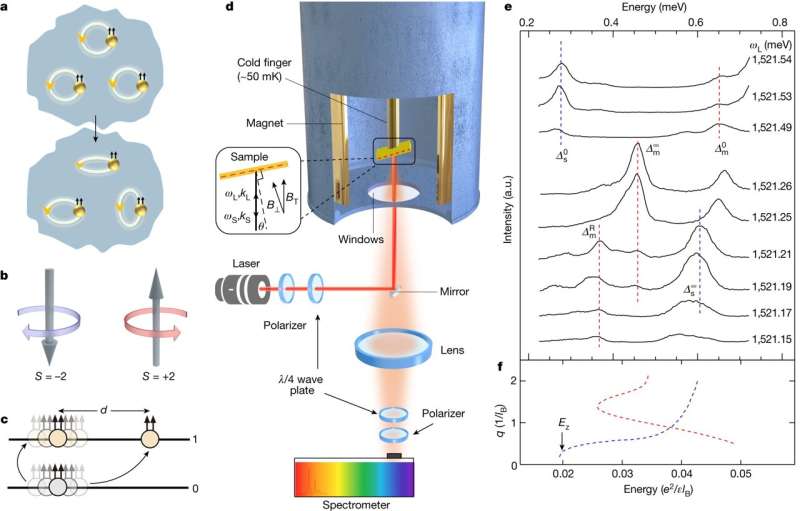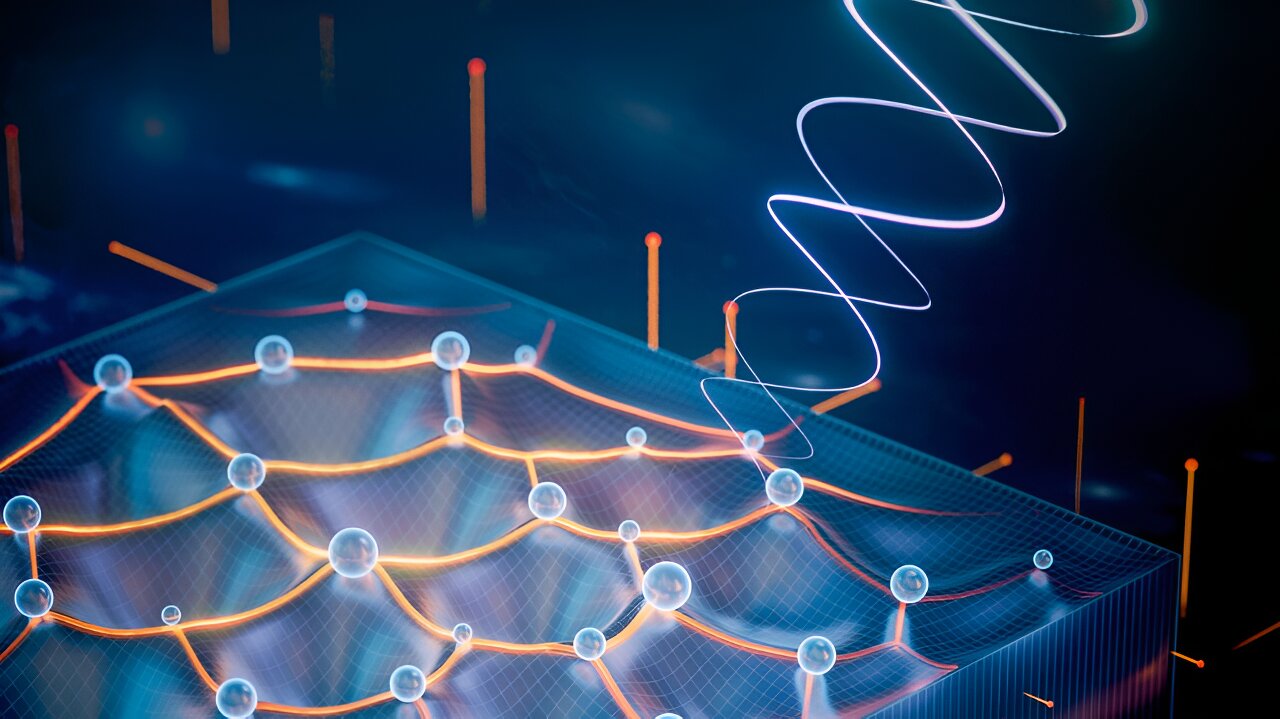A team of scientists from Columbia, Nanjing University, Princeton, and the University of Munster, writing in the journal Nature, have presented the first experimental evidence of collective excitations with spin called chiral graviton modes (CGMs) in a semiconducting material.
A CGM appears to be similar to a graviton, a yet-to-be-discovered elementary particle better known in high-energy quantum physics for hypothetically giving rise to gravity, one of the fundamental forces in the universe, whose ultimate cause remains mysterious.
The ability to study graviton-like particles in the lab could help fill critical gaps between quantum mechanics and Einstein’s theories of relativity, solving a major dilemma in physics and expanding our understanding of the universe.
“Our experiment marks the first experimental substantiation of this concept of gravitons, posited by pioneering works in quantum gravity since the 1930s, in a condensed matter system,” said Lingjie Du, a former Columbia postdoc and senior author on the paper.
The team discovered the particle in a type of condensed matter called a fractional quantum Hall effect (FQHE) liquid. FQHE liquids are a system of strongly interacting electrons that occur in two dimensions at high magnetic fields and low temperatures. They can be theoretically described using quantum geometry, emerging mathematical concepts that apply to the minute physical distances at which quantum mechanics influences physical phenomena.
Electrons in an FQHE are subject to what’s known as a quantum metric that had been predicted to give rise to CGMs in response to light. However, in the decade since the quantum metric theory was first proposed for FQHEs, limited experimental techniques existed to test its predictions.
For much of his career, the Columbia physicist Aron Pinczuk studied the mysteries of FQHE liquids and worked to develop experimental tools that could probe such complex quantum systems. Pinczuk, who joined Columbia from Bell Labs in 1998 and was a professor of physics and applied physics, passed away in 2022, but his lab and its alumni across the globe have continued his legacy. Those alumni include article authors Ziyu Liu, who graduated with his Ph.D. in physics from Columbia last year, and former Columbia postdocs Du, now at Nanjing University, and Ursula Wurstbauer, now at the University of Münster.
“Aron pioneered the approach of studying exotic phases of matter, including emergent quantum phases in solid state nanosystems, by the low-lying collective excitation spectra that are their unique fingerprints,” commented Wurstbauer, a co-author on the current work.
“I am truly happy that his last genius proposal and research idea was so successful and is now published in Nature. However, it is sad that he cannot celebrate it with us. He always put a strong focus on the people behind the results.”

One of the techniques Pinczuk established was called low-temperature resonant inelastic scattering, which measures how light particles, or photons, scatter when they hit a material, thus revealing the material’s underlying properties.
Liu and his co-authors on the paper adapted the technique to use what’s known as circularly polarized light, in which the photons have a particular spin. When the polarized photons interact with a particle like a CGM that also spins, the sign of the photons’ spin will change in response in a more distinctive way than if they were interacting with other types of modes.
The new paper was an international collaboration. Using samples prepared by Pinczuk’s long-time collaborators at Princeton, Liu and Columbia physicist Cory Dean completed a series of measurements at Columbia. They then sent the sample for experiments in low-temperature optical equipment that Du spent over three years building in his new lab in China.
They observed physical properties consistent with those predicted by quantum geometry for CGMs, including their spin-2 nature, characteristic energy gaps between its ground and excited states, and dependence on so-called filling factors, which relate the number of electrons in the system to its magnetic field.
CGMs share those characteristics with gravitons, a still-undiscovered particle predicted to play a critical role in gravity. Both CGMs and gravitons are the result of quantized metric fluctuations, explained Liu, in which the fabric of spacetime is randomly pulled and stretched in different directions.
The theory behind the team’s results can therefore potentially connect two subfields of physics: high energy physics, which operates across the largest scales of the universe, and condensed matter physics, which studies materials and the atomic and electronic interactions that give them their unique properties.
In future work, Liu says the polarized light technique should be straightforward to apply to FQHE liquids at higher energy levels than they explored in the current paper. It should also apply to additional types of quantum systems where quantum geometry predicts unique properties from collective particles, such as superconductors.
“For a long time, there was this mystery about how long wavelength collective modes, like CGMs, could be probed in experiments. We provide experimental evidence that supports quantum geometry predictions,” said Liu. “I think Aron would be very proud to see this extension of his techniques and new understanding of a system he had studied for a long time.”
More information:
Jiehui Liang et al, Evidence for chiral graviton modes in fractional quantum Hall liquids, Nature (2024). DOI: 10.1038/s41586-024-07201-w
Citation:
Researchers find first experimental evidence for a graviton-like particle in a quantum material (2024, March 28)
retrieved 28 March 2024
from https://phys.org/news/2024-03-experimental-evidence-graviton-particle-quantum.html
This document is subject to copyright. Apart from any fair dealing for the purpose of private study or research, no
part may be reproduced without the written permission. The content is provided for information purposes only.

